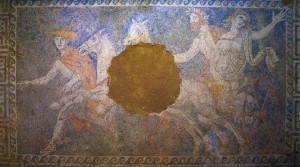The scene of Persephone’s abduction which was revealed in the Amphipolis tomb is unique as to the fact that a mosaic of such high artistic value in a tomb is also seen elsewhere.
Two of Verginas’ Macedonian tombs, both appearing to belong to women, according to archaeologists, also bear Persephone’s abduction as artistic expressions on walls of great artistic skill.
The first mural, which is considered an epitome of ancient drawing is found in “Tomb I” in Aegae, next to the one attributed to Phillip the Second. It is a cist grave where archaeologists believe Nikisipoli is buried, one of Phillip’s wives. The mural is found inside the tomb and it depicts Pluto abducting Persephone, while the artist also added Persephone’s mother, Demeter and the three Fates. Hermes the Soul-guide is also depicted in this.
The next depiction of Persephone is found in Eurydice’s’ tomb, mother of Phillip the Second and adorns the back of the unique throne found therein. The backrest of the throne depicts the four horses of Pluto and Persephone. The mural is “en face” since we see the chariot from the front, while the faces and bodies of the figures do not portray movement. Instead, the four horses, two brown and two white, depict great movement.

Although the unique mosaic of Amphipolis is very reminiscent of the Aegae tomb, it is also found in two tombs attributed to the Timenides dynasty. Thus the person entombed might have wanted to underline their relationship with said dynasty. Something like that does not preclude the possibility of it being a political or familial relation, but it all still remains a mystery.
Ask me anything
Explore related questions







